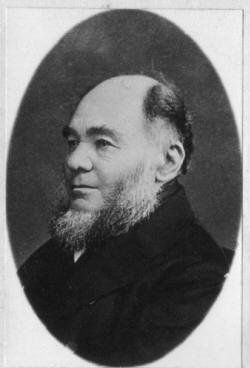

Queer Places:
University of Cambridge, 4 Mill Ln, Cambridge CB2 1RZ
Kitlands, Coldharbour, Dorking RH5 6HQ, UK
Christ Church Churchyard
Coldharbour, Mole Valley District, Surrey, England
 Douglas Denon Heath (January 6, 1811 – September 25, 1897) was an English barrister and judge, known also as a literary editor, classical scholar and writer on physics.
He was part of the Cambridge
Apostles.
Douglas Denon Heath (January 6, 1811 – September 25, 1897) was an English barrister and judge, known also as a literary editor, classical scholar and writer on physics.
He was part of the Cambridge
Apostles.
The second son of George Heath, serjeant-at-law and son of James Heath the engraver, and Anne Raymond Dunbar, he was born in Chancery Lane, London, on 6 January 1811, younger brother of John Moore Heath,[1] and the older brother of Dunbar Isidore Heath,[2] and Leopold Heath. After school at Greenwich, he spent most of 1826-7 with friends of his father's in France, including his godfather Vivant Denon. He went into residence at Trinity College, Cambridge, in October 1828, and read for a year with Henry Malden. Among his Cambridge friends was James Spedding, with whom he visited William Wordsworth and Alfred Tennyson. Heath obtained a scholarship at Trinity on 23 April 1830, and two years later graduated senior wrangler, and took the first Smith's prize. In the classical tripos of the same year (1832) he was placed ninth in the first class, in a strong year. He was elected to a Trinity fellowship on 2 October 1832.[3][4] Heath entered the Inner Temple, and was called to the bar in 1835. In 1838 his father gained him the reversion of his own post as county clerk of Middlesex. In 1846 the courts of the county clerk were abolished; Heath declined to retire on full salary, and took on the work of a county court judge in the Bloomsbury district.[3] On his father's death in 1852, Heath became owner of Kitlands, a small estate near Leith Hill, Surrey. He resided there, and Tennyson, Spedding, and William Hepworth Thompson visited. Marianne North painted at Kitlands for the collection at Kew Gardens.[3] Heath was one of the founders and benefactors of the Surrey county school at Cranleigh. He died unmarried at Kitlands on 25 September 1897, and was buried in Coldharbour churchyard.[3] One of the early Cambridge Apostles, he was the last survivor of that group.[5]
My published books: